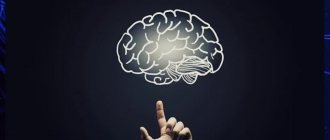Surely most of you have heard the phrase “Conquer yourself and win thousands of battles.” It is this phrase that reflects the whole essence of psychological self-regulation. The ability to control yourself, control your emotions and behavior in various situations is a very important and vital factor for survival in modern society.
Practiced and properly understood self-regulation contributes to prosperity and the fight against stress. To allow yourself to reach this level, you need to be clearly aware of all the types and features of self-control.
What is self-regulation and its types
Therapy specialist Andrea Bell defines self-regulation as the ability to control and restrain oneself from impulsive actions and emotions. The ability to self-regulate helps to resist and thereby control one’s place in society, which indicates the flexibility of a person’s emotional and behavioral state.
In psychology, there are two types of self-regulation:
- emotional - this is the ability to manage your state and emotions. In a moment of depression, lift your mood and the ability to calm down during a period of upset feelings,
— behavioral is the ability to act for the benefit of one’s long-term interests. More precisely, it is the ability to react to various situations, contrary to your feelings.
This is easy to understand using the example of a queue at the checkout. When you are tired, and the cashier is slow and clumsy, and even makes mistakes that lead to proceedings. To his apology and question whether he delayed you too much, you would rather answer, no, with a smile on your face, rather than express everything that you think about him.
For example, correctly developed self-regulation can also include:
- the child stops hysterics when asked to buy him a new toy in return,
- the decision of people to take a break in a sharp discussion in order to prevent a quarrel and not lead the situation to insults,
- choosing low-calorie foods if you want to lose weight.
Such control of emotions helps to achieve certain goals, solve many important problems, and even become a leader in your environment.
It is important to understand that self-regulation includes and makes the following human abilities stronger:
- using self-control to behave with dignity in society and not succumb to weaknesses: alcohol, smoking, using swear words,
- the ability to manage your energy in order to properly distribute the load and achieve desired goals,
- ability to maintain calm and restraint in unpleasant and difficult situations,
- the ability to switch and cope with workload and stress in difficult situations.
It is stress and stressful situations that are decisive factors in self-regulation and the ability to manifest it consciously and unconsciously.
Self-regulation: the meaning of a biological term
Any living system, from a cell to a biogeocenosis, is constantly exposed to various external factors. Temperature conditions, humidity change, food runs out, or interspecific competition intensifies—there are a lot of examples. Moreover, the viability of any system depends on its ability to maintain a constant internal environment (homeostasis). It is to achieve such a goal that self-regulation exists. The definition of the concept implies that changes in the external environment are not direct factors of impact. They are converted into signals that cause one or another imbalance and lead to the launch of self-regulation mechanisms designed to return the system to a stable state. At each level, such interaction of factors looks different, so to understand what self-regulation is, let’s look at them in more detail.
What is stress and why is it dangerous?
Stress is an invisible weapon that leads to the destruction of body cells and ultimately manifests itself through various diseases. After a stressful situation occurs, impulses are formed in the human brain that are sent to the cardiovascular, immune and endocrine systems. This is quite enough not only to disrupt self-control and lose vigilance, but also to cause a number of complex diseases. When stress becomes chronic, its effects can be devastating.
The famous neuroendocrinologist McEwen, winner of many prizes and awards, proved:
- prolonged stress has a very bad effect on human memory, which leads to atrophy of neurons,
— acute and prolonged stress suppresses the body’s immune functions, making it weak and defenseless to resistance,
— in the process of stress, the human body produces glucocorticoids, which in the short term have a beneficial effect on it. But as a result of prolonged stress and increased levels of glucocorticoids in the body, it prevents insulin from working in the body, which helps in the absorption of glucose.
It is important to note that stress interferes with:
- control your own fear,
- reduces reproductive functions in the stronger sex,
- damages teeth and gums,
- leads to imbalance throughout the body.
CONCEPT OF SELF-REGULATION OF LIVING SYSTEMS
CONCEPT OF SELF-REGULATION OF LIVING SYSTEMS
Self-regulation
- in biology, the property of biological systems to automatically establish and maintain at a certain, relatively constant level certain physiological or other biological indicators. With self-regulation, control factors do not influence the regulated system from the outside, but are formed within it. "Biological encyclopedic dictionary"
Self-regulation in a system is the internal regulation of processes with their subordination to a single stable order. (slide 2)
Moreover, even in changing environmental conditions, a living system retains the relative internal constancy of its composition and properties - homeostasis (from the Greek homoios - similar, identical and stasis - state).
Indeed, the environment is very changeable. Temperature, light, and humidity change. For animals, and even for plants, the availability of food is not regular. They are pestered by parasites, predators and simply competitors for habitat. Nevertheless, animals and plants endure these environmental fluctuations, live, grow, and reproduce. Ecological communities maintain a certain average composition for a long time.
The founder of the idea of physiological homeostasis, Claude Bernard, considered the stability of physicochemical conditions in the internal environment as the basis for the freedom and independence of living organisms in a continuously changing external environment. (slide 3)
Self-regulation occurs at all levels of organization of biological systems - from molecular genetic to biosphere (slide 4). Therefore, the problem of homeostasis in biology is interdisciplinary in nature. To maintain homeostasis in all systems, cybernetic principles of self-regulating systems are used. Cybernetics, the science of control, explains the principle of self-regulation of a system based on direct and feedback connections between its elements. A system is a collection of interacting elements. Direct communication between two elements means the transfer of information from the first to the second in one direction, feedback means the transfer of response information from the second element to the first. The point is that an information signal—direct or reverse—changes the state of the system receiving the signal. And here it is fundamentally important what sign the response signal will be - positive or negative. Accordingly, the feedback will be positive or negative. In the case of positive feedback, the first element signals the second about some changes in its state, and in response receives a command to consolidate this new state and even change it further. Cycle after cycle, the first element, with the help of the second (control) element, accumulates the same changes, its state stably changes in one direction. (Fig. 1a).
slide 5
This situation is characterized as self-organization, development, evolution, and there is no need to talk about any stability of the system. This can be any growth (of a cell, an organism, a population), a change in the species composition in a community of organisms, a change in the concentration of mutations in the gene pool of a population, leading through selection to the evolution of species. Naturally, positive feedback connections not only do not support, but, on the contrary, destroy homeostasis.
Feedback negative connection stimulates changes in the regulated system with the opposite sign relative to those primary changes that gave rise to the direct connection. Initial shifts in the system parameters are eliminated, and it returns to its original state. The cyclic combination of direct positive and reverse negative connections can, theoretically, be infinitely long, since the system oscillates around a certain equilibrium state (Fig. 1b). Thus ,
To maintain system homeostasis, the principle of negative feedback is used.
Next, using specific examples, we will show the self-regulation of biological systems of different levels of complexity.
INTRACELLULAR SELF-REGULATION
In a cell, chemical (molecular) regulatory mechanisms are mainly used to maintain homeostasis. Most important is the regulation of genes on which the production of proteins depends, including numerous and varied enzymes.
The simplest model for demonstrating gene homeostasis is the regulation of the production of an enzyme for the breakdown of lactose in Escherichia coli. To break down and assimilate lactose, messenger RNA and, subsequently, an enzyme are synthesized from a specific structural gene that is part of the lactose operon (the gene along with the regulatory region). If there is no sugar in the medium, the enzyme is not produced, but when sugar is added, the gene is activated and the enzyme is synthesized. But as soon as all the sugar is used by the cell, the gene stops working. How does a cell know about the presence of sugar and its consumption? How does he protect his genes from useless work and waste of energy? It turns out that the lactose operon in Escherichia coli works on the principle of negative feedback, where a special part of the operon, the operator, acts as a regulatory “valve,” and the food substrate itself, lactose, acts as a regulator. Lactose entering the cell itself opens the structural gene, using the operator site as a key. The disappearance of lactose automatically leads to the closure of the gene (slide 6).
In its simplicity, the system of gene regulation by substrate concentration is similar to simple technical regulators. However, in eukaryotes the regulation of gene activity is more complex.
Another example of simple self-regulating systems using negative feedback is represented by enzymatic chains inhibited by the final product. The essence of regulation is that the final product has an affinity for the first enzyme. By binding to the enzyme, the product inhibits (suppresses) its activity, as it completely distorts its tertiary structure. The following regulatory cycle is at work. When the concentration of the final product increases above the required level, its excess inhibits the enzyme chain (to do this, it is enough to stop the very first enzyme). Fermentation stops, and the free product is spent on the needs of the cell. After some time, a deficiency of the product occurs, the block on the enzymes is removed, the chain is activated, and the production of the product increases again. (slide 7)
The third example is the maintenance of intracellular osmotic homeostasis. In the mechanism of occurrence of nerve impulses, sodium ions play an important role, the concentration of which outside the cell must be maintained at a higher level than inside. Thanks to sodium pumps built into the cell membrane, the desired ion gradient is maintained. As soon as a cell receives excess sodium, the sodium pump (its enzyme that breaks down ATP and provides energy) is activated. Sodium is pumped out, its concentration in the cell drops, which serves as a signal to turn off the pump. (slide 
Note, however, that the adjustable parameters are not absolutely constant; they are maintained within acceptable limits. In each case, these are their own physiological boundaries that allow cellular functions to be carried out normally.
SELF-REGULATION OF A MULTICELLULAR ORGANISM
In multicellular organisms, an internal environment appears in which the cells of various organs and tissues are located, and the mechanisms of homeostasis become more complex and improved. During evolution, specialized organs of circulatory, respiratory, digestive, excretory, etc. are formed that are involved in maintaining homeostasis.
Homeostasis is most perfect in mammals, which enhances their ability to adapt to the environment. In mammals, as well as in birds, body temperature is regulated within narrow limits - they are called warm-blooded animals.
The main role in maintaining homeostasis of the body is played by the nervous and hormonal regulatory systems (slide 9).
The most important integrating function is performed by the central nervous system, especially the cerebral cortex. The autonomic nervous system, in particular its sympathetic division, is also of great importance. Hormonal regulation is provided by the endocrine gland system. The central endocrine gland - the pituitary gland - has a direct connection with the brain (through the hypothalamus), and its hormones affect all local endocrine glands through the blood.
Hormones secreted by the endocrine glands are distributed through the bloodstream (humorally) to all target organs and participate in the regulation of their growth and functioning. Thus, in fact, thanks to the connection between the nervous and endocrine systems, a unified neurohormonal self-regulation of the body is carried out. (slide 10)
The regulation of eating behavior in vertebrates and humans is interesting and indicative. The hypothalamus contains the centers of hunger and satiety. A lack of glucose occurs in the blood of a hungry animal (or person). Low blood glucose concentration leads to irritation of the hunger center. Nerve fibers send commands to the brain and muscles, and the search for food is organized. When food is found, the mechanisms of nutrition, digestion and absorption of products into the blood are activated. The concentration of glucose in the blood increases, which leads to irritation of the saturation center, further to suppression of appetite and cessation of nutrition. When glucose is consumed, its concentration in the blood decreases again, which irritates the hunger center. The cycle repeats. Since the hypothalamus is connected both to the nerve centers and to the entire endocrine system, the cycle of eating behavior is also synchronized with the neuro-reflex and humoral regulation of the glands of the digestive tract: saliva, gastric juice, pancreatic and intestinal enzymes are released, peristalsis is mobilized. (slide 11)
The negative feedback mechanism is involved in maintaining a constant number of cells in renewing tissues, such as blood, intestinal or skin epithelium. (slide 12)
These tissues contain a reserve of undifferentiated cells (for example, red bone marrow for blood) that repeatedly divide, differentiate, work, age and die. It is believed that mature cells secrete substances that inhibit young dividing cells. A chain of interdependent reactions is built: with an excess of mature cells, inhibitor production is high and cell proliferation is suppressed; a decrease in the number of mature cells as a result of their natural death is accompanied by a decrease in the concentration of the inhibitor in the medium; the cell division block is removed; the proliferation of young cells increases; the number of mature cells is restored. Then the inhibitor production increases again and the cycle repeats. The total number of mature cells in the tissue fluctuates around a certain average level and does not sharply decrease or increase. According to the mechanism of signal transmission, here we have a humoral system; the inhibitor works as an interstitial “hormone”.
Among the regulatory systems that ensure the internal constancy of the body, in addition to the nervous and endocrine ones, include the immune system (slide 13), which monitors and maintains the genetic purity of the internal environment and tissues of the body, eliminating invading viruses, microbes or its own mutant cells. As in the case of intracellular regulation, we must note that the homeostasis of the body is not absolute. Any parameters: body temperature, blood pressure, eating behavior, heart rate, number of cells in tissue and many others are in an oscillatory mode. This follows from the very nature of the regulation mechanism - direct and feedback are closed in a cycle, the rotation of which requires a certain time. During this time, the controlled system manages to change in one direction or another, which is expressed in fluctuations in its parameters. But the average level of the parameter must correspond to the norm, and the range of its fluctuations must not go beyond physiological limits.
Normal fluctuations in the functional characteristics of the body occur constantly and are called biorhythms. (slide 14) The rate of protein synthesis in a cell fluctuates in a near-hourly (1.5 - 2 hours) rhythm; most organismal rhythms have a near-daily periodicity; there are monthly, annual and even long-term rhythms. The vast majority of biorhythms are induced; they are formed under the influence of abiotic (non-biological) rhythms of the external environment. In general, the oscillatory state of the system is the most stable. That is why the oscillatory state of the internal environment of the body acts as an important factor in maintaining homeostasis.
SELF-REGULATION IN ECOSYSTEMS
The concept of ecosystem homeostasis in ecology was developed by F. Clements (1949) (slide 15). Equilibrium in ecosystems by feedback processes. Homeostasis is the ability of a population or ecosystem to maintain stable dynamic equilibrium in changing environmental conditions. In homeostasis (stability) of living systems there are:
- Endurance (survivability, tolerance - the ability to withstand changes in the environment without disturbing the basic properties of the system.
- Elasticity (resistance, resistance) is the ability to quickly independently return to a normal state from an unstable one, which arose as a result of external adverse effects on the system.
Population homeostasis is determined by the maintenance of spatial structure, density and genetic diversity. At the ecosystem level, homeostasis manifests itself in the most stable forms of interaction between species, which is expressed in adaptation to the characteristics of the environment and the maintenance of nutrient cycles. One can even consider the homeostasis of the biosphere, in which the interaction of various organisms maintains the constancy of the gas composition of the atmosphere, the composition of soils, the composition and concentration of salts of the world ocean, etc.
Homeostasis is ensured by the operation of regulatory mechanisms operating on the principle of negative feedback. Sudden changes in environmental characteristics, in which they (or one of them) go beyond the acceptable limits, are called environmental stress.
In ecosystems, as a result of the interaction of the circulation of substances, energy flows and feedback signals from subsystems, self-regulating homeostasis arises. Control mechanisms at the ecosystem level include, for example, subsystems such as the microbial population that regulates the accumulation and release of nutrients.
The “predator-prey” subsystem also regulates the density of both predator and prey populations. Let's consider the simplest ecosystem: hare-lynx, consisting of two trophic levels. (slide 16) When the number of hares is small, each of them can find enough food and comfortable shelters for themselves and their cubs. Those. environmental resistance is low, and the number of hares increases, despite the presence of a predator. The abundance of hares makes it easier for lynx to hunt and feed their young. As a result, the number of predators also increases. This shows positive feedback. However, as the number of hares increases, the amount of food and shelter decreases and predation increases, i.e. environmental resistance increases. As a result, the number of hares is decreasing. It becomes more difficult for predators to hunt, they experience a lack of food and their numbers fall. This manifests itself as a negative feedback that compensates for deviations and returns the ecosystem to its original state.
Such fluctuations occur periodically around a certain average level. The growth, decline and persistence of a population depends on the relationship between biotic potential and environmental resistance. The principle of population change: this is the result of an imbalance between biotic potential and the resistance of its environment. Such an equilibrium is dynamic, because environmental resistance factors rarely remain unchanged for a long time. (slide 17)
Equilibrium in ecosystems is ensured by the redundancy of organisms performing the same functions. For example, if there are several plant species in a community, each of which develops in its own temperature range, then the rate of photosynthesis of the ecosystem may remain almost unchanged for a long time. As stress increases, the system may be unable to return to its previous level, although it remains manageable. For ecosystems, not one, but several equilibrium states are possible. After stressful influences, they often return to another, new, state of equilibrium.
For example, a huge amount of CO2 entering the atmosphere as a result of human activity is absorbed by the ocean carbonate buffer system and autotrophs: (slide 18)
CO2 + CaCO3 + H2O = Ca (HCO3)2
Light
CO2 + H2O = (CH2O) n+ O2.
As the influx of CO2 increases, the buffer capacity of the biosphere may become insufficient, and a new equilibrium will be established in the atmosphere between
CO2 and O2. In this case, even small changes can have far-reaching consequences: evolutionary adjustment must occur for reliable homeostatic control to reappear. In addition to those discussed, there are many other mechanisms that ensure the stability and homeostasis of ecosystems. For example, the ability of a population to adapt to new environmental conditions depends on the degree of heterozygosity. Competition is also a mechanism of homeostasis.
Balance is a relative concept. Equilibrium in natural ecosystems depends on population density. If the population density increases, environmental resistance increases, and therefore mortality increases and population growth stops. And, conversely, with a decrease in population density, environmental resistance weakens and the previous number is restored. Human impact on nature often leads to the extinction of populations, because does not depend on population density.
The stability of ecosystems in ecology means the property of any system to return to its original state after it has been removed from a state of equilibrium. Stability is determined by the resistance of ecosystems to external influences. There are two types of stability: resistant and elastic.
Resistance is the ability of an ecosystem to resist disturbances, maintaining its structure and function unchanged.
Elastic stability is the ability of a system to quickly recover after a disruption of structure and function.
It is difficult for a system to simultaneously develop both types of stability: they are connected by feedback, and sometimes exclude each other. For example, the California redwood forest is resistant to fire (high resilience), but if it burns, it recovers very slowly or not at all (low resilience). Heather thickets easily burn out (low resistance resistance), but quickly recover (high elastic resistance)
Man is the most powerful creature capable of changing the functioning of ecosystems. The human brain has so far relied primarily on positive feedback to control and dominate nature. This led to the development of technology and increased exploitation of resources. But this process will ultimately lead to a decrease in the quality of life and destruction of the environment if ways of adequate control through negative feedback are not found.
The existence of humanity is possible only if the regulatory mechanisms that allow the biosphere to adapt to certain anthropogenic influences are preserved. In an effort to reduce the level of environmental pollution, a person should equally strive to preserve the self-regulatory mechanisms that support the natural life support systems of the planet, i.e. to preserve the ecological balance established in nature, which is not always achieved only by reducing the level of pollution and economical use of natural resources.
Conclusion (slide 19)
Self-regulation and maintenance of a stable state - homeostasis - is a mandatory property of living systems, regardless of their level of complexity. The relative constancy of the physical and chemical parameters of the cell is regulated and maintained. The state of the tissues and organs of a multicellular organism is maintained within the physiological norm. The composition of living communities in biocenoses is reproduced. The basis for maintaining homeostasis is the universal principle of negative feedback.
At the same time, living systems change directionally and irreversibly and self-organize, which is the essence of their development. Cells differentiate, work and die. Organisms grow, reproduce, age and die. Biocenoses undergo succession and also change irreversibly with climate change on Earth. A directed change in a biosystem is essentially the opposite of homeostasis; it occurs on the basis of positive feedback.
The stability and immutability of biosystems, on the one hand, and their gradual change and development, on the other, represent a dialectical unity of opposites, which is expressed by the concept of sustainable development.
Literature:
1. A.P. Anisimov The concept of modern natural science. Biology. Far Eastern State University, Pacific Institute of Distance Education and Technology, Vladivostok, 2000
2 Biological encyclopedic dictionary
External influence
Maintaining homeostasis is accompanied by constant external influence. Changing conditions around the ecosystem lead to the need to adjust internal processes. There are several sustainability criteria:
- high and balanced reproductive potential of individuals;
- adaptation of individual organisms to changing environmental conditions;
- species diversity and branched food chains.
These three conditions help maintain the ecosystem in a state of dynamic equilibrium. Thus, at the level of biogeocenosis, self-regulation in biology is the reproduction of individuals, conservation of numbers and resistance to environmental factors. In this case, as in the case of an individual organism, the equilibrium of the system cannot be absolute.
The concept of self-regulation of living systems extends the described patterns to human communities and public institutions. Its principles are also widely used in psychology. In fact, this is one of the fundamental theories of modern natural science.
At the head of everything
Self-regulation, the determination of certain adjustments in the body’s activity, underlies all changes in the body and its reactions to external stimuli. Stress and constant loads can lead to hypertrophy of individual organs. An example of this is the developed muscles of athletes and the enlarged lungs of freedivers. The stressor is often illness. Cardiac hypertrophy is a common occurrence in people diagnosed with obesity. This is the body’s response to the need to increase the load on pumping blood.
Self-regulation mechanisms also underlie the physiological reactions that occur during fear. A large amount of the hormone adrenaline is released into the blood, which causes a number of changes: increased oxygen consumption, increased glucose, increased heart rate and mobilization of the muscular system. At the same time, the overall balance is maintained by extinguishing the activity of other components: digestion slows down, sexual reflexes disappear.
Increasing complexity
Self-regulation in nature is always based on the principle of feedback and generally follows a similar scenario. However, at each subsequent level factors appear that complicate the process. For a cell, it is important to maintain a constant internal environment and maintain a certain concentration of various substances. At the next level, the process of self-regulation is called upon to solve many more problems. Therefore, multicellular organisms develop entire systems that maintain homeostasis. These are the respiratory, excretory, circulatory organs and the like. The study of the evolution of the animal and plant world easily makes it clear how, as the structure and external conditions became more complex, the mechanisms of self-regulation improved.
Organismal level
The constancy of the internal environment is best maintained in mammals. The basis for the development of self-regulation and its implementation is the nervous and humoral system. Constantly interacting, they control the processes occurring in the body and contribute to the creation and maintenance of dynamic balance. The brain receives signals from nerve fibers present in every part of the body. Information from the endocrine glands also flows here. The relationship between nervous and hormonal regulation often contributes to almost instantaneous restructuring of ongoing processes.
Self-regulation methods
The processes occurring at each of these levels are externally different in scale, the energy sources used and their results, but are similar in essence. They are based on the same methods of self-regulation of systems. First of all, it is a feedback mechanism. It is possible in two versions: positive and negative. Let us recall that direct communication involves the transfer of information from one element of the system to another, the reverse one flows in the opposite direction, from the second to the first. In this case, both of them change the state of the receiving component.
Positive feedback leads to the fact that the processes that the first element reported to the second are reinforced and continue to be implemented. A similar process underlies all growth and development. The second element constantly signals the first about the need to continue the same processes. This disrupts the stability of the system.











